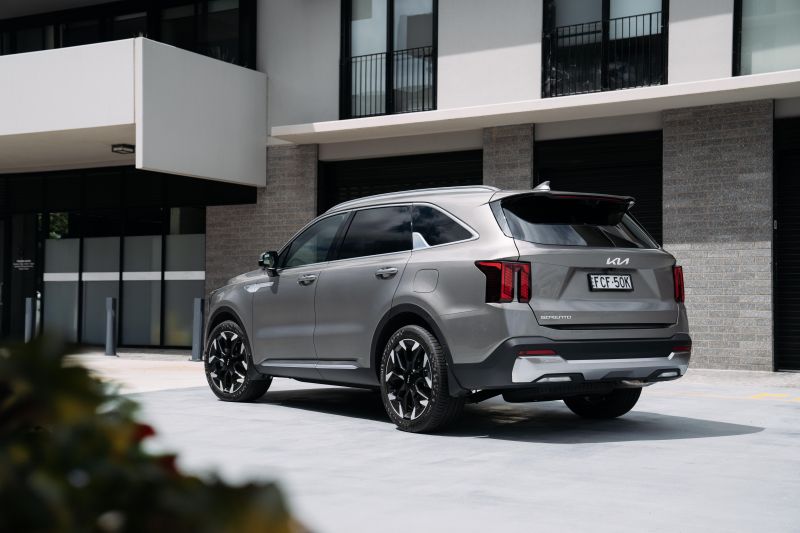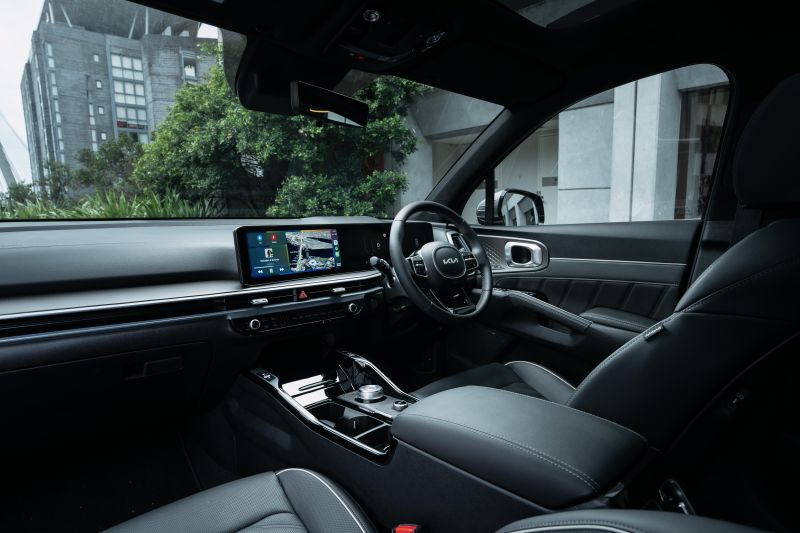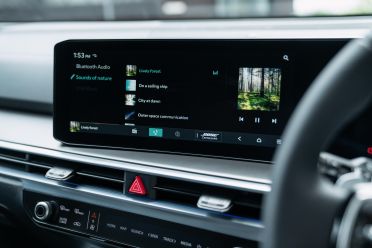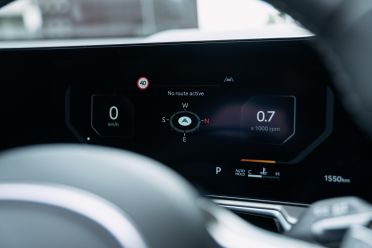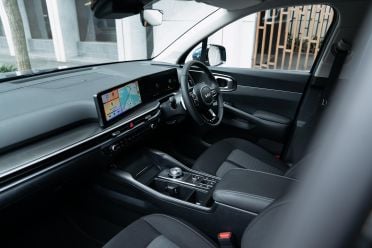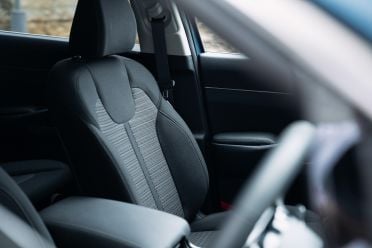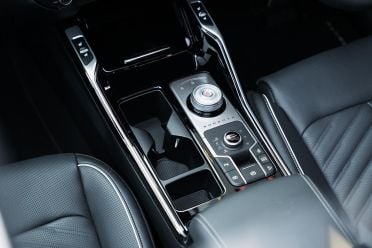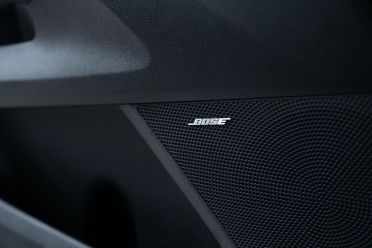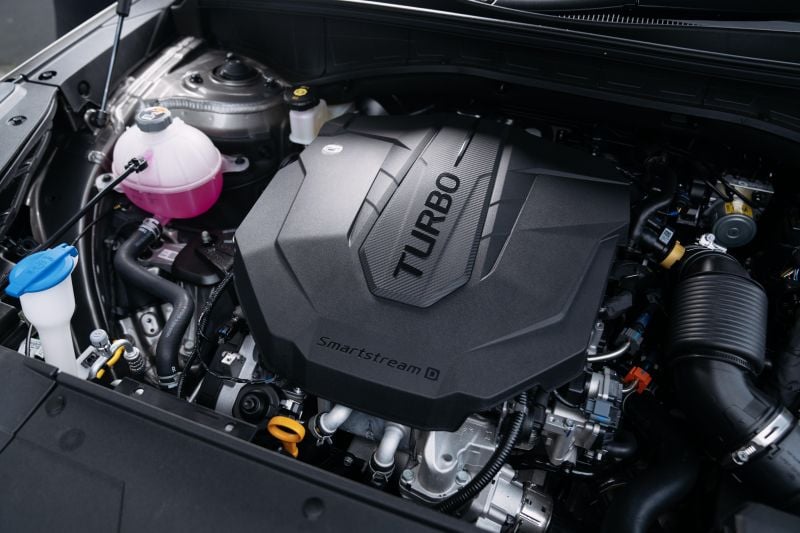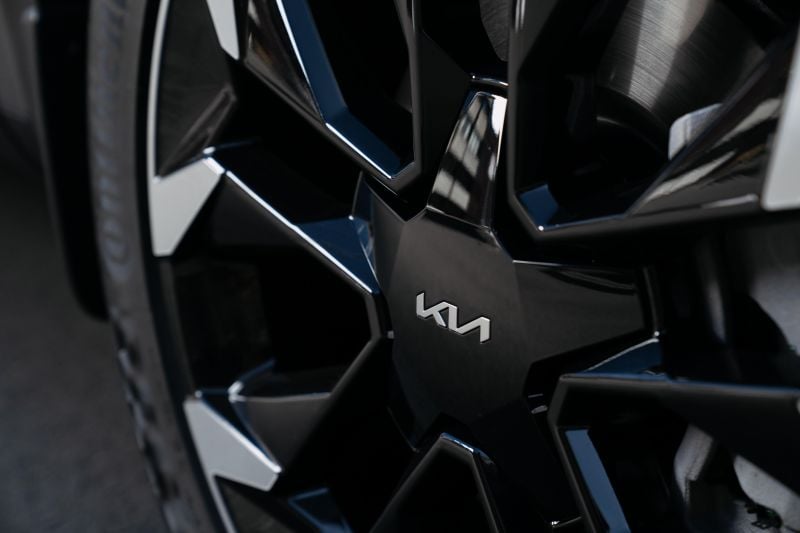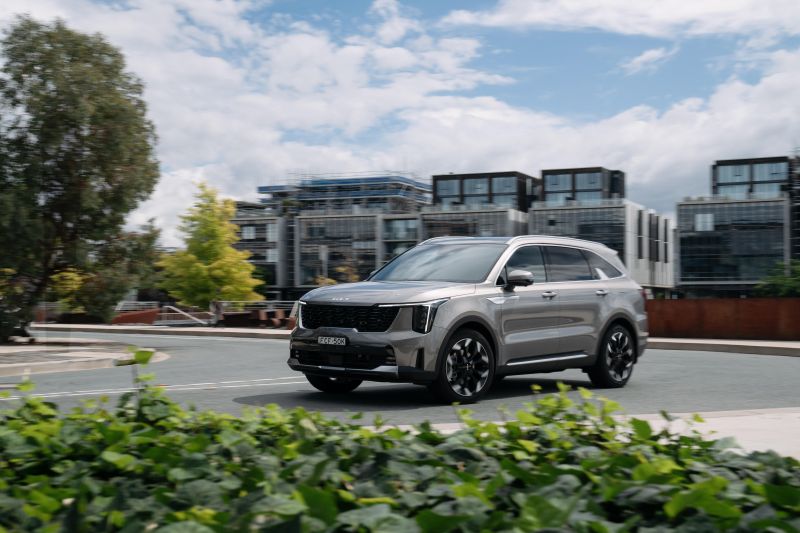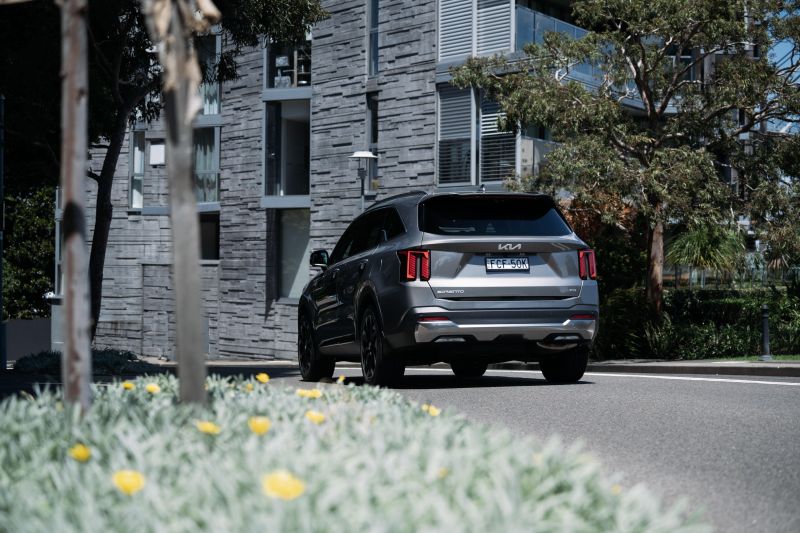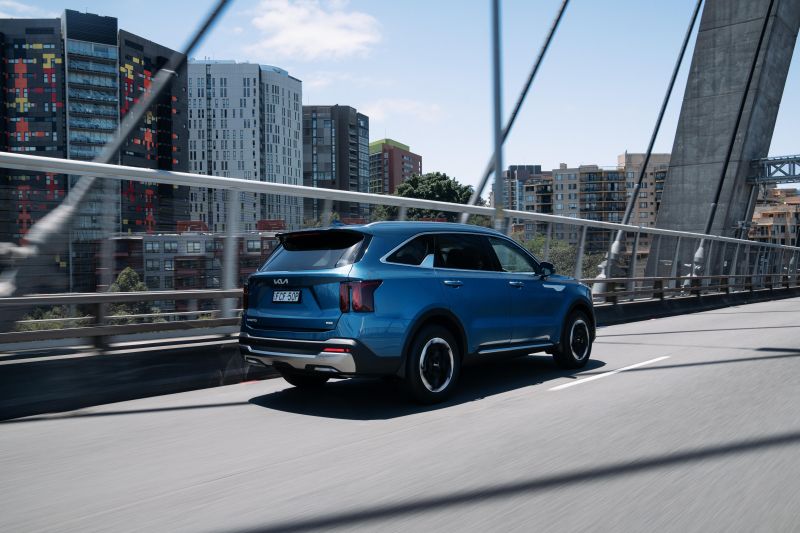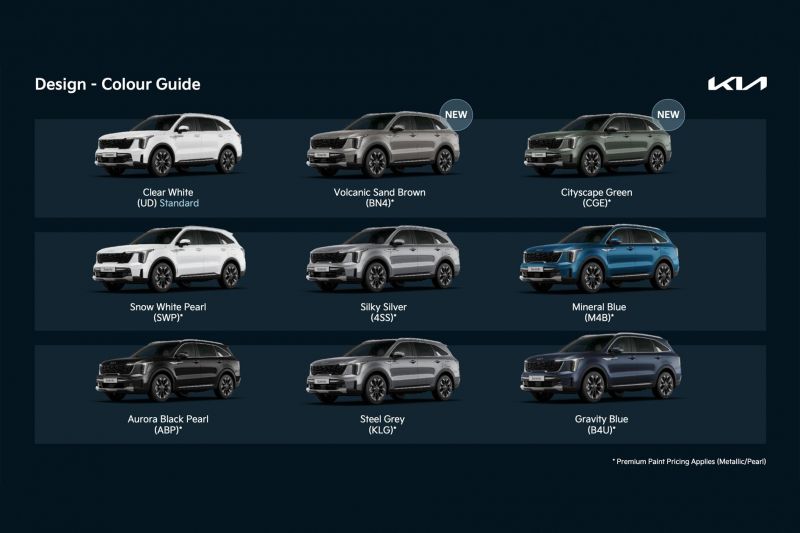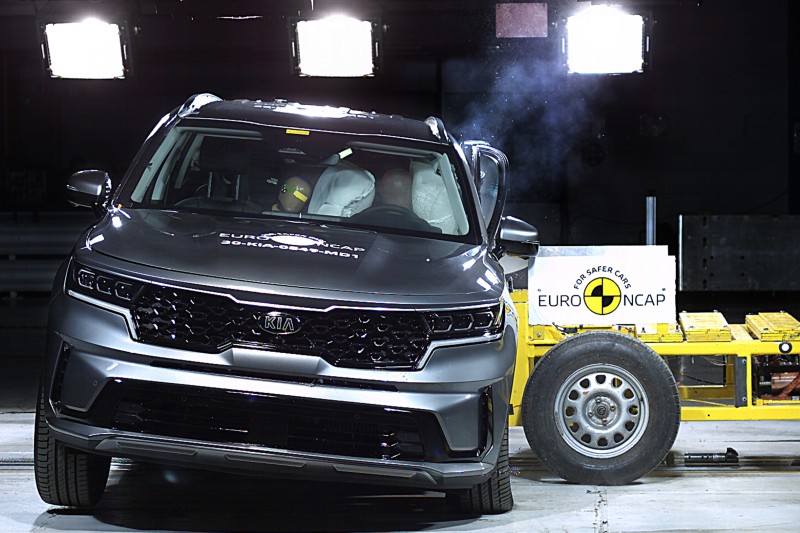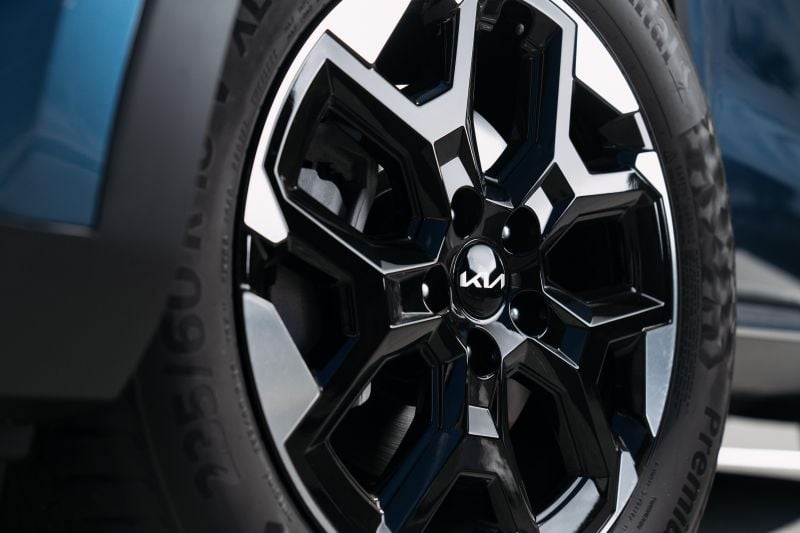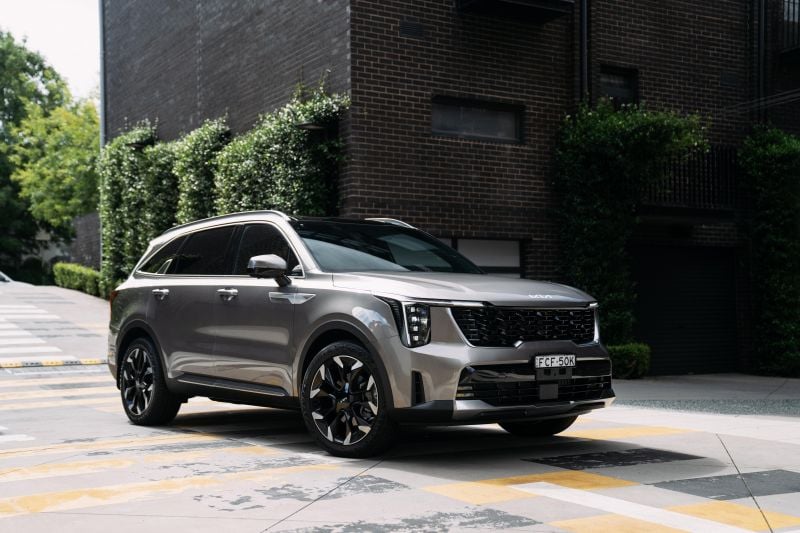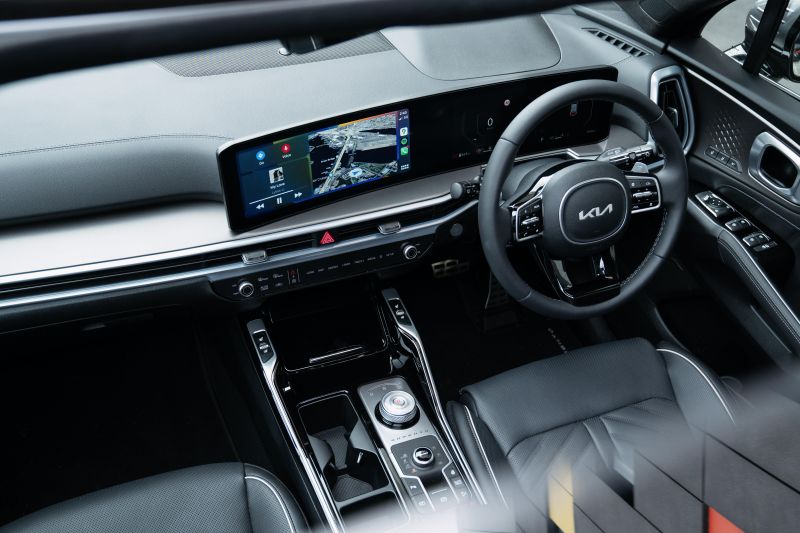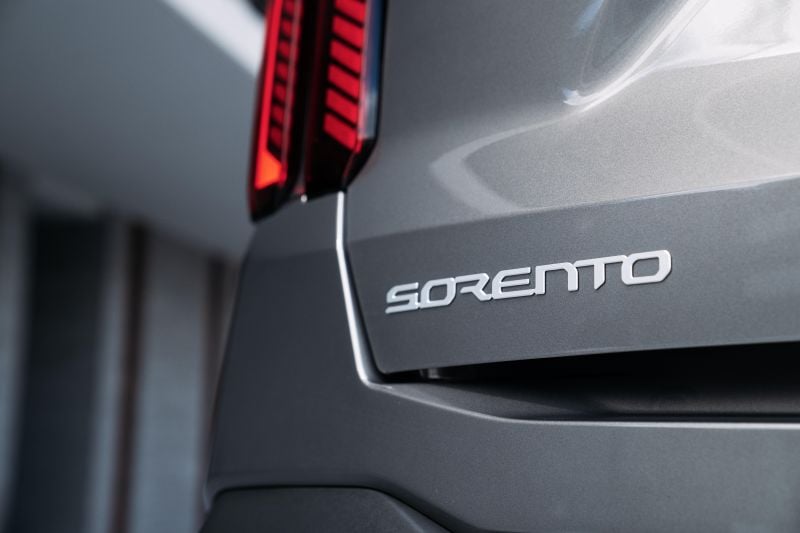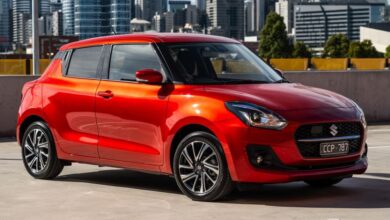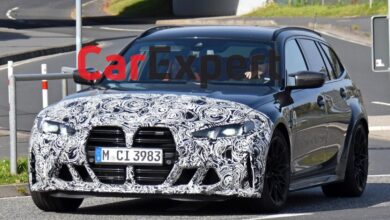2024 Kia Sorento review | CarExpert

The Kia Sorento has evolved plenty of times already, and it’s just hit a new stage of life.
Now in its fourth generation, the Korean brand’s global family hero – if you discount the expensive electric EV9 – has just been treated to a tech-heavy mid-life facelift.
With each iteration the Sorento has moved further upmarket, and this latest 2024 model isn’t just taking aim at the likes of the Hyundai Santa Fe and Toyota Kluger – but also the more expensive Audi Q7 and Volvo XC90.
Don’t believe me? Kia openly talks about benchmarking the XC90 and Volkswagen Touareg during the development stages of this car; and given with how well it drives, that’s no surprise.
Headlining the changes are a revised suspension tune with new damper technology, as well as a slew of upgraded infotainment and driver assistance technologies. Oh, and now it’s got a new face inspired by the EV9.
While not the top-selling vehicle in its segment, demand for the Sorento – particularly the flagship GT-Line – is so strong customers have previously been advised of wait times between 12 and 18 months.
Kia Australia told us at the launch of this updated model wait times should be closer to three or four months depending on variant, though that could blow out if this new one is well received. We’re also waiting on the Sorento Hybrid and Plug-in Hybrid, which will follow in the second quarter of 2024.
Is it still one of our top picks? Time to find out.
How does the Kia Sorento fare vs its competitors?
View a detailed breakdown of the Kia Sorento against similarly sized vehicles.

Kia
Sorento
How much does the Kia Sorento cost?
Prices are up for 2024, though that is somewhat offset by enhanced levels of standard equipment.
Kia Sorento pricing:
- 2024 Kia Sorento S V6 FWD: $54,090 (+$3300)
- 2024 Kia Sorento Sport V6 FWD: $57,090 (+$3300)
- 2024 Kia Sorento S Diesel AWD: $57,090 (+$3300)
- 2024 Kia Sorento Sport Diesel: $60,090 (+$3300)
- 2024 Kia Sorento Sport+ V6 FWD: $61,990 (+$3600)
- 2024 Kia Sorento Sport+ Diesel AWD: $64,990 (+$3600)
- 2024 Kia Sorento GT-Line V6 FWD: $69,690 (+$3700)
- 2024 Kia Sorento GT-Line Diesel AWD: $72,690 (+$3700)
Prices are drive-away
The Kia Sorento goes head-to-head with a range of seven-seat SUVs in Australia. To see how it shapes up, use our tool to build your own comparison.
What is the Kia Sorento like on the inside?
It’s a bit of ‘something old, something new’.
The design of the cabin has a sense of familiarity but also has some pretty significant changes to the dashboard. All versions of the Sorento come as standard with a conjoined display incorporating the driver’s cluster and infotainment touchscreen, though the quality of the display depends on variant.
Even the base Sorento S scores a 12.3-inch touchscreen with Kia Connect, though the entry grade misses out on satellite navigation. Wireless Apple CarPlay and Android Auto are also standard across the board, as is DAB radio.
S, Sport, and Sport+ grades no longer have conventional gauges in the instrument cluster, instead packing the ‘basic’ digital cluster which sandwiches a 4.0-inch colour trip computer between clock radio-style rev and speedo readouts.
If you opt for the GT-Line flagship, you get the upscale twin 12.3-inch array which effectively gives the Sorento the same full digital cockpit as the EV9.
The new Sorento GT-Line also has a larger 10-inch head-up display with better graphics, and can now project turn-by-turn navigation prompts from third-party mapping apps from smartphones. Further, there’s a digital rear-view mirror on the flagship too.
The basic cluster is a bit meh but will change colours according to drive modes; the high-grade unit is more befitting of the Sorento’s status and also offers the option of simple line-bar counters with digital readouts or conventional dials that can be adjusted with different themes.
Kia’s latest software is at play here, meaning the aforementioned wireless smartphone mirroring across the range (yay!) as well as the newest iteration of Kia Connect which brings features including connected navigation (Sport and above), over the air software updates, cabin pre-conditioning and more.
Higher grades offer extended functionality too, such as surround camera snapshots on the GT-Line, and you can also control the vehicle’s windows on Sport+ and GT-Line models with auto up/down functionality.
All of this is accessed via the Kia Connect smartphone app, which we unfortunately didn’t get to trial during the media launch. We’ve tried these features in other Kias, and they’re handy once you get it all set up.
Wireless Apple CarPlay worked pretty well during our time with the Sorento, and the inbuilt navigation system proved handy when we took a wrong turn during the drive route.
The Bose 12-speaker premium audio system in the Sport+ and GT-Line is also good, with crisp audio and punchy bass. We unfortunately didn’t get time in the lower grades to trial the standard seven-speaker system.
Comfort and space up front is pretty good, with plenty of nooks and crannies to store your odds and ends like phones, wallets, and keys. There’s a big shelf under the centre stack for your phone, toothed cupholders, and several bins and cubbies – though the door pockets will only fit smaller bottles.
I will say only the GT-Line offers a wireless phone fast charger despite all models getting wireless smartphone mirroring; and some of the cubbies aren’t felt or rubber lined so harder items can rattle around a bit.
Another new feature of the Sorento is the integrated touch bar that doubles as the climate control panel and virtual hard controls for the infotainment system. We’ve seen this on the EV6 and Sportage already, and unlike some touch-based controls by other brands the Kia ones work much like conventional switchgear.
Gone is the old T-bar shifter of the lower grades in the pre-facelift range. Now, all models get a rotary selector that offers haptic feedback when you engage reverse. It has an almost crystal finish that’s quite fetching – though in DCT models it can be a little slow to engage the selected gear.
As before, the GT-Line gets a slew of proper luxury features like heated and ventilated front seats (heated for Sport+ too), while the Sport+ and GT-Line feature a heated steering wheel and manual rear sunshades. A panoramic sunroof is again reserved for the flagship, and it’s a great feature if your kids like to look up at the sky while in the car.
Not much has changed in the rear other than some new seat designs and new USB-C ports on the seat backs of higher models, but there’s still plenty of goodness in the second and third rows.
Adults can easily fit behind adults in the second row, even three abreast without it being too much of a squeeze. The third row is one of the more practical for the segment, though it’s not as good as the Palisade or Carnival and the curtain airbags only cover that thin window – and therefore technically don’t offer full three-row coverage.
The Sorento is also very kid-friendly, with five top-tether and four ISOFIX anchors meaning you can fill up the rear two rows with child capsules if you need the space. The second row has a one-touch entrance function too to make getting in and out of the rearmost seats easier.
The third row seating itself remains one of the better in class, with enough room for average-sized adults for shorter journeys and more than enough space for kids. All versions get second-row vents, though the S misses out on third-row vents and fan controls. Also disappointingly, the Sorento doesn’t get a proper third zone of automatic climate control like numerous rivals do.
Rounding out the rear amenities are a fold-down centre armrest with cupholders, net-type map pockets behind the front seats, cup holders and bottle holders in the doors themselves, as well as a 12V outlet behind the centre console. GT-Line models also feature heated outer second-row seats.
Boot space remains the same for the updated range. There’s 179L with the third row in place, 608L with five seats up, and 1996L with just two seats in play – all measurements are VDA.
Regardless of which Sorento you choose, there’s a full-size alloy spare wheel under the boot floor as well. Props to Kia for continuing to offer this, which no doubt will be a key point of difference to many buyers.
What’s under the bonnet?
Powertrains are carried over from the pre-facelift Sorento range.
The ‘standard’ option is a 3.5-litre naturally aspirated V6 petrol engine, which quotes outputs of 200kW (6300rpm) and 332Nm (5000rpm). Drive is sent to the front wheels via an eight-speed torque converter automatic transmission.
If you want all-wheel drive, the sole option you have at launch is a 2.2-litre turbocharged four-cylinder turbo-diesel which makes 148kW (3800rpm) and 440Nm (1750-2750rpm). The oiler swaps out the torque converter auto for an eight-speed wet-type dual-clutch auto.
The Sorento’s all-wheel drive system is the active on-demand type which features a Lock Mode, as well as various terrain modes which are accessible via a rotary controller on the centre console.
Kia has confirmed the Sorento 3.5 FWD and 2.2D AWD are rated to tow up to 2000kg with a braked trailer, with max towball download quoted at 200kg.
Later during the second quarter of 2024, the Sorento Hybrid and Plug-in Hybrid will arrive in Australia. Like the petrol and diesel versions, they’re effectively carryover drivetrains.
Power in the Kia Sorento Hybrid comes from a 1.6-litre turbocharged four-cylinder petrol engine teamed with a six-speed automatic, as well as a 44kW/264Nm electric motor and 1.49kWh lithium-ion polymer battery.
System outputs are rated at 169kW and 350Nm, which is a little down on power compared to the PHEV’s. A Toyota Kluger Hybrid, by comparison, offers 184kW.
The Plug-in Hybrid uses a larger 13.8kWh water-cooled li-ion battery and a more powerful 67kW/304Nm e-motor, for system outputs of 195kW and 350Nm.
The PHEV can also run on pure electric power, up to 57km on the WLTP combined cycle and up to 70km on a pure urban cycle – at least based on the pre-facelifted spec. It’s unclear whether the facelift will bring any changes.
How does the Kia Sorento drive?
While the drivetrains are carryover, Kia Australia has been hard at work retuning the Sorento for our roads.
The 2024 Sorento has received a new ride and handling tune – including revised power steering and new frequency selective dampers first seen on the EV6 GT and EV9 – claimed to improve ride comfort and body control.
All versions of the Sorento have been recalibrated, including the Hybrid and Plug-in Hybrid which previously went without a full local tune. Graeme Gambold and his team have led Kia’s local tuning program for a decade, with over 50 Kia-branded models subject to localised calibration programs over the last decade or so.
To showcase this the media drive took us from Melbourne CBD to the Yarra Valley, through the hills outside Healesville and up the winding roads of Mount Donna Buang in Victoria’s outer east. We got a mix of freeway, highway, city and suburban roads, mixed in with winding country B-roads and even a dirt section.
We started off in the penultimate Sport+ variant with the V6 FWD drivetrain option.
As I found in my recent review of the pre-facelift GT-Line V6 FWD, the Sorento’s atmo six is a sweet unit that loves to rev and is the more refined pick of the non-hybrid variants.
It offers a smooth and brassy note under acceleration, and while it won’t set your pants on fire with its straight-line performance, it gets along nicely if with a bit of wheelspin if you hit the throttle too hard off the line.
Once you’re moving, the eight-speed conventional auto is a slick picker of ratios, though the lower torque output and rev-happy nature of the V6 means it can occasionally feel like it’s hunting for gears if you demand rolling response.
That said, it’s capable of smooth progress in town and on the highway, and if you don’t need the extra traction of the diesel and want to pocket some cash (it’s $3000 cheaper), it could be a great option for you.
I piloted the V6 through some twisty sections of road where I test performance cars due to their fast corners and high signposted speed limits.
The Sorento V6 was a surprisingly fun steer through Myers Creek Road for such a big car, showcasing the claimed improvements brought about by the new chassis calibration.
It’s not like the old car was a dud handler either, if anything it was already very good. The updated model feels that bit more tied together but with an added layer of compliance that was lacking in the pre-update model, particularly on larger wheels.
Flick it into Sport mode and there’s a noticeable change to the steering and throttle response, which definitely goes further to make the Sorento feel like a much smaller vehicle than it actually is.
Swapping into the heavier GT-Line Diesel AWD, there was a different personality with similar talents.
The torquey four-cylinder oiler has a more relaxed, effortless character that requests more gentle throttle inputs, otherwise it gets a bit rattly when pushed.
It likes to lean on that 440Nm peak torque output from low down, and the eight-speed DCT is a snappy shifter on the move – though it can exhibit some of those hesitant low-speed quirks associated with this transmission type.
The front end also feels heavier than the V6, but the diesel was pretty impressive up and down Mt Donna Buang’s 100km/h roads, as well as a twisty dirt section that came about right as the weather turned a little… wet. You will notice the AWD’s added traction on wet or loose surfaces coming out of corners on faster roads.
Driving back to Melbourne in the GT-Line also demonstrated the gains in comfort compared to the outgoing car, which had a habit of being a bit jittery or terse on pockmarked city roads.
While the diesel-powered GT-Line we tested isn’t as supple as air-sprung European cars over Melbourne streets, it definitely didn’t feel as busy as its predecessor. It’s not quite as good in these scenarios – particularly on 20-inch wheels – as something like a Hyundai Palisade, or even the Kia Carnival.
Overall refinement is pretty good for the class, with good insulation from road and wind noise, though the roughest of roads will transmit some tyre roar into the cabin, particularly on larger wheels and skinnier tyres.
If efficiency is a priority and you can’t wait for the HEV or PHEV, the diesel is the clear pick in that arena. We got it as low as mid-6.0L/100km with more freeway driving, settling into the 7.0s with mixed conditions; meanwhile the petrol hovered around the 10-11L/100km mark with similar driving.
Driver assistance tech has also been given a boost, but certain elements may not feel like ‘upgrades’.
I’m talking about the speed limit assistance system, which is an annoying audible warning that chimes each time you eclipse the signed speed limit – even if it’s just 1-2km/h. This latest iteration is a claimed 3dB quieter than before, but it’s still bloody annoying and defaults to on each time you start the car.
Otherwise, the new Highway Driving Assist system is a nav-based semi-autonomous assistant that engages adaptive cruise control with stop/go, as well as Lane Following Assist (centring) to take the load off longer highway stints. You can also get it to automatically adjust the speed to changes in signed limits, which is handy.
It’s a shame about the speed limit assist because otherwise everything works rather well, and you’re not left wanting for a whole lot.
What do you get?
Sorento S highlights:
- 7 seats
- 17-inch alloy wheels
- Full-size spare wheel
- Auto reflector-type LED headlights (NEW)
- Auto high-beam
- LED daytime running
- LED front fog lights
- LED rear fog light
- Rain-sensing wipers
- Power-folding side mirrors
- Acoustic windscreen
- Basic digital instrument cluster incl. 4-inch LCD display (NEW)
- 12.3-inch touchscreen infotainment system (NEW)
- Wired Apple CarPlay, Android Auto
- Wireless Apple CarPlay, Android Auto (NEW)
- DAB+ digital radio
- 6-speaker sound system
- Manual air-conditioning
- 2nd row vents
- Proximity entry and push-button start
- Remote engine start
- Shift-by-wire gear selector (NEW)
- Leatherette-wrapped steering wheel
- Paddle shifters (NEW)
- Embossed cloth seats
- 6-way manual driver’s seat adjustment
Sorento Sport adds:
- 18-inch alloy wheels
- Privacy glass (NEW)
- Satellite navigation
- Dual-zone climate control
- Automatic defog
- 3rd row fan control and vents
- Electrochromic rear-view mirror
- 10-way power driver’s seat incl. 2-way lumbar support
- Highway Driving Assist (NEW)
Sorento Sport+ adds:
- 19-inch alloy wheels
- LED combination tail lights
- Heated side mirrors
- Aero-blade type front wipers
- 12-speaker Bose premium audio
- 2nd row USB chargers
- 3rd row USB chargers
- 2nd row sunshade blinds
- Black high-gloss interior trim
- Alloy door scuff panels
- Heated steering wheel
- Leather upholstery
- Heated front seats
Sorento GT-Line adds:
- 20-inch alloy wheels
- 4-cube LED projector headlights
- Panoramic glass sunroof
- Side mirror reverse dip function
- 12.3-inch digital instrument cluster
- Passenger talk function
- Head-up display
- Wireless charger
- Digital rear-view mirror (NEW)
- Interior ambient lighting
- Alloy sports pedals
- Suede headliner
- Luggage net
- Quilted Nappa leather upholstery
- 14-way power driver’s seat incl. 4-way lumbar support
- 10-way power front passenger’s seat
- Ventilated front seats
- Heated outboard 2nd row seats
- Blind Spot View Monitor
- Safe Exit Assist
- Electronic child safety lock
- Surround-view monitor
- Side parking sensors
- Remote Smart Parking Assist
Colours
Standard: $NCO
Premium: $695
- Volcanic Sand Brown (NEW)
- Cityscape Green (NEW)
- Snow White Pearl
- Silky Silver
- Mineral Blue
- Aurora Black Pearl
- Steel Grey
- Gravity Blue
Is the Kia Sorento safe?
The 2024 Kia Sorento carries over the pre-update model’s five-star ANCAP safety rating, based on Euro NCAP tests.
The Sorento managed an adult occupant protection score of 82 per cent, child occupant protection score of 85 per cent, vulnerable road user protection score of 63 per cent, and safety assist score of 89 per cent.
Standard safety features include:
- 7 airbags incl. front-centre
- Adaptive cruise control
- Autonomous emergency braking (AEB)
- Car detection
- Pedestrian detection
- Cyclist detection
- Junction assist
- Blind-spot assist
- Driver attention alert
- Highway Driving Assist (HDA)
- Adaptive cruise incl. stop/go
- Lane Following Assist
- Navigation-based
- Lane Following Assist
- Lane keep assist
- Intelligent Speed Limit Assist (NEW)
- Parking sensors front, rear
- Rear cross-traffic assist
- Reversing camera
- Safe Exit Warning
- Tyre pressure monitoring
Kia Connect features include:
- eCall
- Remote lock
- Remote climate control
- Vehicle tracking
- Vehicle status monitoring
- Voice assistant
- Destination send to vehicle
- Real-time traffic updates
- Valet parking mode
It’s worth noting the updated Australian range doesn’t pick up more airbags like Korean models, which get rear-side inflators and a driver’s knee airbag – bringing the total to 10. Local models also appear to miss out on the ‘reverse guide lamp’ that’s similar to the rear lights offered by Genesis models.
How much does the Kia Sorento cost to run?
The 2024 Kia Sorento is covered by a seven-year, unlimited-kilometre warranty like the wider the Kia line-up.
Scheduled maintenance is required every 15,000km or 12 months, whichever comes first. Owners who service their cars within the dealer network also get up to eight years of free roadside assist.
2024 Kia Sorento service pricing:
| Engine: | 12mth/15,000km | 24mth/30,000km | 36mth/45,000km | 48mth/60,000km | 60mth/75,000km | 72mth/90,000km | 84mth/105,000km |
|---|---|---|---|---|---|---|---|
| 3.5 V6 FWD | $369.34 | $581.15 | $444.55 | $763.62 | $415.70 | $730.79 | $441.01 |
| 2.2D AWD | $370.36 | $582.26 | $445.67 | $817.19 | $416.85 | $712.95 | $442.24 |
Compared to the outgoing range, the petrol and diesel are $20-30 up per visit. While offering industry leading warranty coverage and one of the longest capped-price service programs, Kia Australia has made a habit of being one of the more costly brands to service.
Petrol, HEV and PHEV versions of the Sorento can run on 91 RON regular unleaded, while the diesel takes… diesel.
All models feature a 67-litre fuel tank, and Kia’s local arm sticks to older Euro 5 emissions standards, meaning no AdBlue for the diesel. There’s also no idle stop/start on ICE models unlike other markets, so you’ll use more fuel in traffic or when idling on the school run.
CarExpert’s Take on the Kia Sorento
This is a very good update of an already very good family SUV.
With heaps of space, sharp looks, and a luxurious feature list higher up the range, there’s little wonder so many families have been lining up for the Sorento, even as wait times increase.
This mid-life upgrade addresses key areas for improvement on the old model, namely the infotainment tech and adding some of the more desirable features previously reserved for the GT-Line further down; while the retuned steering and chassis makes for an even more engaging drive.
The speed limit warning still grates, but it’s less intrusive than the system in the Seltos and Palisade. I lament the pricey servicing and the fact only the GT-Line gets the proper panoramic display package given the Sorento’s price point – it should be standard on the Sport+ too at a minimum.
Having new colours is a win (yay Cityscape Green), but the interior offerings are again greyscale. Kia Australia noted challenges with sourcing lighter leather options from Korea, though we’d like to see more choice given the ‘premium’ labelling and $70,000 price point.
It’s also a shame there have been no real developments to the drivetrains, though the carryover set is still decent. The diesel is the pick for all-round drivability and efficiency – and is currently your sole AWD option – though the cheaper V6 FWD will be favourable for those who believe a big car deserves a big-block power unit.
The upcoming Sorento HEV and PHEV will pad the drivetrain line-up nicely, with the HEV probably the pick if your Sorento is likely to spend most of its life in suburbia like so many. Good luck getting one if supply is set to remain at 20-ish units per month.
Even with the price rises relative to its predecessor, the Sorento still represents solid value against the competition. The GT-Line at $70,000 is still thousands cheaper than a Kluger Grande, and lines up in price against the entry-level Mazda CX-90 for reference. It’s also decently more affordable than the larger Palisade, which runs older tech.
All told, the updated Sorento reasserts itself as one of the class leaders, though competition continues to heat up. Personally, I’d try to get a deposit down for one of the hybrids if you can afford to wait a little longer.
Click the images for the full gallery
BUY: Kia Sorento
MORE: Everything Kia Sorento
